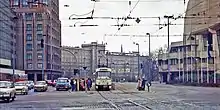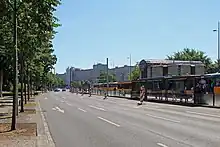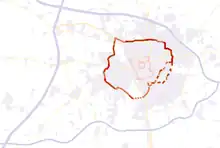51°20′26″N 12°22′34″E / 51.3406°N 12.3761°E
.svg.png.webp)
The Inner City Ring Road in Leipzig (also called Ring for short) in the district of Mitte is the ring road around Leipzig's city centre. It encloses the just 0.7 km2 (0.27 sq.mi.) large area[1] of the old town without the former Vorstadts.
History

The Leipzig inner city ring road almost completely traces the course of the former town fortifications, which were torn down after the Seven Years' War (1756-1763). Striking corner points within the town fortifications were the town gates. Since the beginning of the 18th century, the fortifications have been planted with avenues, which formed a ring of promenades (in German: Promenadenring),[2] some of which consisted of several rows, up until the middle of the century. The name was transferred to the later horticulturally designed areas, which to this day almost completely surround the city center within the ring road. The Promenadenring is the oldest municipal landscape park in Germany[3] and one of the most important garden and cultural heritage monuments in Leipzig. The expansion to the traffic ring road took place between 1904 and 1912.[4]
During the period of the Peaceful Revolution in 1989, the Monday demonstrations led from Augustusplatz to almost the entire Ring.
Sections and names of the ring road



The total of the about 3.6 kilometers (2.24 mi.) long[5][6] ring road is now laid out as a four to six lane road with a continuous tram track body and consists of the following sections (starting clockwise at the main station):
- the 1133 meter long (3717 ft.)[5][7] Willy-Brandt-Platz (named after Chancellor Willy Brandt; formerly the square in front of the Thuringian train station, Blücherplatz, Karl-Legien-Platz and Platz der Republik) in front of Leipzig Hauptbahnhof,
- the 750 meter long (2461 ft.)[8] Georgiring (named after the mayor of Leipzig Otto Georgi; formerly Bahnhofstraße), which runs in a north–south direction,
- the 305 meter long (1001 ft.) east side [9] of Augustusplatz (named after Frederick Augustus I of Saxony; formerly Grimmaischer Thorplatz and meanwhile Karl-Marx-Platz, which stretches from the main façade of the opera to the Europahaus,
- the 409 meter long (1342 ft.) Roßplatz to the south, turning to the west. The green park Schillerpark to the north was designed by Peter Joseph Lenné in 1857,
- the 107 meter (351 ft.) long north side[10] of Wilhelm-Leuschner-Platz (named after the social democratic politician Wilhelm Leuschner; formerly Königsplatz, which means King's Place),
- the 593 meter long (1946 ft.) Martin-Luther-Ring (after the reformer Martin Luther; formerly Obstmarkt, An der Pleiße und Rathausring) running from east to west, which turns north in front of the New Town Hall and ends in the Wilhelm-Leuschner-Platz-Nonnenmühlgasse and from Lotterstraße it is divided into a main and a side tour,[11]
- the 468 meter long (1535 feet) Dittrichring (named after the Mayor of Leipzig, Rudolf Dittrich; formerly An der Pleiße and Thomasring), which is divided by a green area into a main and a side course,[12] which also passes the Thomaskirche, which opens out into Gottschedstraße opposite,
- the 361 meter long (1184 ft.) eastern section[13] of the Goerdelerring (named after the Mayor of Leipzig, Carl Friedrich Goerdeler; formerly the separate Fleischerplatz and Schulplatz squares, which were combined into Friedrich-Engels-Platz in 1945), which follows the course after passing the "round corner"-building[14] continues in a north-easterly direction - the section of the Geordelerring running west between Pfaffendorfer Straße and Jacobstraße and merging into the Ranstädter Steinweg can, because of the after World War II changed road layout are no longer assigned to the actual inner city ring road,
- and finally the 827 meter long (2713 ft.),[8] west–east running Tröndlinring (named after the mayor of Leipzig, Carl Bruno Tröndlin; formerly Am Löhrschen Platze) between Pfaffendorfer Straße and Gerberstraße, which then leads back to Willy-Brandt-Platz.
Youngest namings
| Section | Decision-making | Effective Date | Note |
|---|---|---|---|
| Willy-Brandt-Platz | 16 November 1993 | 18 December 1993 | |
| Georgiring | 1899 | ||
| Augustusplatz | 2 October 1990 | 3 October 1990 | |
| Wilhelm-Leuschner-Platz | 1 August 1945 | ||
| Martin-Luther-Ring | 3 November 1933 | 10 November 1933 | |
| Dittrichring | 3 November 1917 | 22 December 1917 | |
| Goerdelerring | 19 November 1991 | 1 January 1992 | only renaming of Friedrich-Engels-Platz into Goerdelerring |
| Tröndlinring | 20 June 1908 | 1 January 1909 | |
The inner city ring road in the Leipzig road network

Depending on the section, the inner city ring road had a traffic volume of 26,000 to 50,000 vehicles/24 hours in 2015.[15] The inner city ring is the innermost ring in the ring system of the Leipzig road network (see figure Ring roads in Leipzig). The figure shows the so-called Tangentenviereck as a further ring, then the (unfinished) Mittlerer Ring (middle ring), highlighted in colour, and the Autobahn[16] on the very outside. Bundesstraße 6 (Willy-Brandt-Platz) and Bundesstraße 87 (Tröndlinring) run over the inner city ring road. The Bundesstraße 2 also ran over the inner city ring road before from the Berlin bridge in the north the connection via Rackwitzer Straße, the east and south side of the Tangentenviereck was passable. The degree of expansion of the inner city ring corresponds to this high traffic volume (72,800 vehicles / 24 hours at the Gerberstraße junction (Hallesches Tor), 30,700 vehicles / 24 hours at the Thomaskirchhof / Gottschedstraße junction).[17]
Bicycle traffic

Since 1975, a minimum speed of 40 km/h (24,85 mph) was stipulated for the inner city ring by the StVO[18] sign ![]() "mandatory minimum speed". On 17 February 2011, the road traffic authority of the city of Leipzig lifted the order for a minimum speed, removed the signs and posted signs with the StVO sign
"mandatory minimum speed". On 17 February 2011, the road traffic authority of the city of Leipzig lifted the order for a minimum speed, removed the signs and posted signs with the StVO sign ![]() "ban on cyclists". On 22 November 2012, a plaintiff filed an appeal against the ban on cycling on the carriageway on certain sections of the Inner City Ring Road (Promenadenring). He prevailed before the Saxon Higher Administrative Court.[19] The city of Leipzig is implementing the judgment in sections, accompanied by lively public discussions.[20] In 2022, green bike lanes were pigmented on several sections of the inner city ring road.
"ban on cyclists". On 22 November 2012, a plaintiff filed an appeal against the ban on cycling on the carriageway on certain sections of the Inner City Ring Road (Promenadenring). He prevailed before the Saxon Higher Administrative Court.[19] The city of Leipzig is implementing the judgment in sections, accompanied by lively public discussions.[20] In 2022, green bike lanes were pigmented on several sections of the inner city ring road.
Traffic reduction efforts
Together with other cities from Poland, the Czech Republic, Italy and Spain, the city of Leipzig took part in the EU project DEMO-EC (Development of sustainable Mobility Management in European Cities) from 2014 to 2020.[21] The contribution of the city of Leipzig was an investigation under the title "Enlargement of car reduced downtown in the inner city of Leipzig". The topic was approached in an interdisciplinary manner by urban, traffic and environmental planning. In the 2018/19 winter semester, students at the Bauhaus University in Weimar developed urban designs under the motto "Reinventing the Ring", which are documented.[22][23] On the one hand, there was a return to the previous history of the ring as a green promenade ring, on the other hand, a preview of expected future developments. The modal split in Leipzig is changing in the direction of a rapidly growing share of cycling. A strong increase in population is forecast for the Mitte district in particular (2015: 61,977 inhabitants, forecast for 2030: 82,549 inhabitants), which in turn means that an increase in traffic volume must be expected.
References
- ↑ K. Lückemeier, J. Richert, U. M. Buchheim, S. Lemke, Leipzig - Innenstadtentwicklung seit 1990 (in German)
- ↑ See also keyword Promenadenring in: Horst Riedel, Stadtlexikon Leipzig von A bis Z , ed. by Pro Leipzig, Leipzig 2005, ISBN 3-936508-03-8 , p. 480 (in German)
- ↑ Kathrin Franz (2005), Helga Schmidt, Gudrun Mayer und Dorothea Wiktorin sowie Sabine Tzschaschel und Jürgen Blenck (ed.), "Der Leipziger Promenadenring - Der erste städtische Landschaftspark Deutschlands", Der Leipzig Atlas, Hermann-Josel Emons Verlag, pp. 124f., in German, ISBN 3-89705-269-5
- ↑ Horst Riedel, ibid.
- 1 2 All specified lengths only include the sections of the respective streets that are part of the inner city ring road as main thoroughfares. They are taken from the street section directory of the City of Leipzig, Verkehrs- und Tiefbauaumt, as of March 1, 2011 (inventory according to Section 4 of the Saxon Roads Act - Sächsisches Straßengesetz (SächsStrG) - of January 21, 1993).
- ↑ After deducting the street lengths repeatedly listed in the inventory for parallel lanes.
- ↑ Including two parallel lanes with turning lanes.
- 1 2 Including two parallel lanes.
- ↑ This length only includes the sections Roßplatz–Grimmaischer Steinweg as a single lane (183 metres or 600 feet) and Grimmaischer Steinweg–Georgiring with two parallel lanes (235 metres).
- ↑ This length only includes the Martin-Luther-Ring–Roßplatz section.
- ↑ The side routes to the north and east of the main road, which also belong to the Martin-Luther-Ring, are another 538 meters or 1765 feet long.
- ↑ The side course east of the main road, which also belongs to the Dittrichring, is another 565 meters long (1854 ft.).
- ↑ This length includes only the Dittrichring–Tröndlinring section including a turning lane.
- ↑ Former District of the Ministry for State Security (Stasi) in Leipzig, today Memorial Museum "Runde Ecke"
- ↑ More differentiated figures contains: Integrated traffic model of the city of Leipzig, traffic concept for the extended inner city, study of traffic on the Leipzig Promenadenring, Power Point presentation on the website of the city of Leipzig (2018) (in German)
- ↑ see also the article by Edeltraud Höfer, Stephan Rausch, Wolfgang Hesse (2005), Helga Schmidt, Gudrun Mayer and Dorothea Wiktorin and Sabine Tzschaschel and Jürgen Blenck (ed.), "Verkehrsausbau für das 21. Jahrhundert", Der Leipzig Atlas, Hermann-Josel Emons Verlag, pp. 202f. (in German), ISBN 3-89705-269-5
{{citation}}: CS1 maint: multiple names: authors list (link) - ↑ cf. Integrated transport model of the city of Leipzig, Power Point presentation
- ↑ abbr.: Straßenverkehrsordnung (the German road traffic regulations)
- ↑ Judgment of the Saxon Higher Administrative Court of 6 September 2018 (in German)
- ↑ Information at the city administration's website on cycling on the Promenadenring, in German, retrieved on 24 July 2022
- ↑ Projects 2014-2020 within the framework of DEMO-EC
- ↑ Bauhaus University Weimar , Professorship for Design and Urban Planning I, Leipziger Promenadenring. Reinventing the ring, documentation of student design work, winter semester 2018/19, in German
- ↑ Städtebaulicher Entwurf des Promenadenrings mit der Bauhaus-Universität Weimar (2018/19) at the website of the city of Leipzig (in German)
Literature
- Gina Klank; Gernot Griebsch: Lexikon Leipziger Straßennamen. Verlag im Wissenschaftszentrum Leipzig, Leipzig 1995, ISBN 3-930433-09-5. (in German)
- Nadja Horsch, Simone Tübbecke (Hrsg.): Bürger Gärten Promenaden. Leipziger Gartenkultur im 18. und 19. Jahrhundert. Passage-Verlag Leipzig 2018, ISBN 978-3-95415-072-4. (in German)
- Andreas Martin, Der Leipziger Promenadenring. Eine Rundfahrt., Lehmstedt Verlag Leipzig 2011, ISBN 978-3-937146-85-0. (in German)